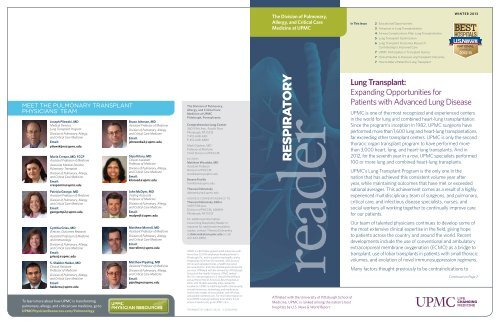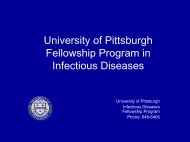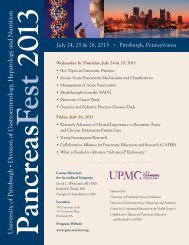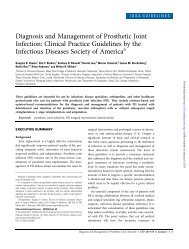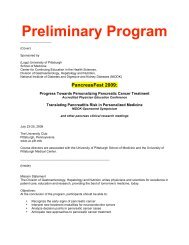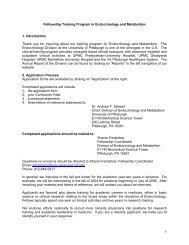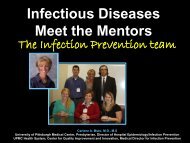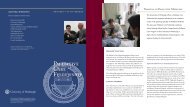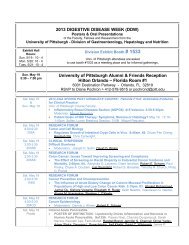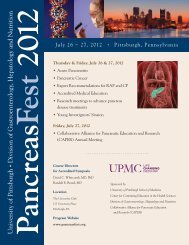Lung Transplant - University of Pittsburgh
Lung Transplant - University of Pittsburgh
Lung Transplant - University of Pittsburgh
Create successful ePaper yourself
Turn your PDF publications into a flip-book with our unique Google optimized e-Paper software.
The Division <strong>of</strong> Pulmonary,<br />
Allergy, and Critical Care<br />
Medicine at UPMC<br />
In This Issue<br />
2 Educational Opportunities<br />
3 Advances in <strong>Lung</strong> <strong>Transplant</strong>ation<br />
4 Airway Complications After <strong>Lung</strong> <strong>Transplant</strong>ation<br />
5 <strong>Lung</strong> <strong>Transplant</strong> Optimization<br />
6 <strong>Lung</strong> <strong>Transplant</strong> Outcomes Research:<br />
Contributing to Improved Care<br />
7 UPMC Participates in <strong>Transplant</strong> Games<br />
7 Clinical Studies to Improve <strong>Lung</strong> <strong>Transplant</strong> Outcomes<br />
7 How to Refer a Patient for <strong>Lung</strong> <strong>Transplant</strong><br />
winter 2013<br />
Meet the PULMONARY TRANSPLANT<br />
PHYSICIANS’ Team<br />
Joseph Pilewski, MD<br />
Medical Director,<br />
<strong>Lung</strong> <strong>Transplant</strong> Program<br />
Division <strong>of</strong> Pulmonary, Allergy,<br />
and Critical Care Medicine<br />
Email:<br />
pilewskijm@upmc.edu<br />
Maria Crespo, MD, FCCP<br />
Assistant Pr<strong>of</strong>essor <strong>of</strong> Medicine<br />
Associate Medical Director,<br />
Pulmonary <strong>Transplant</strong><br />
Division <strong>of</strong> Pulmonary, Allergy,<br />
and Critical Care Medicine<br />
Email:<br />
crespomm@upmc.edu<br />
Patricia George, MD<br />
Assistant Pr<strong>of</strong>essor <strong>of</strong> Medicine<br />
Division <strong>of</strong> Pulmonary, Allergy,<br />
and Critical Care Medicine<br />
Email:<br />
georgemp2@upmc.edu<br />
Cynthia Gries, MD<br />
Director, Outcomes Research<br />
Assistant Pr<strong>of</strong>essor <strong>of</strong> Medicine<br />
and Immunology<br />
Division <strong>of</strong> Pulmonary, Allergy,<br />
and Critical Care Medicine<br />
Email:<br />
griescj@upmc.edu<br />
S. Shabbir Haider, MD<br />
Clinical Assistant<br />
Pr<strong>of</strong>essor <strong>of</strong> Medicine<br />
Division <strong>of</strong> Pulmonary, Allergy,<br />
and Critical Care Medicine<br />
Email:<br />
haiderss@upmc.edu<br />
To learn more about how UPMC is transforming<br />
pulmonary, allergy, and critical care medicine, go to<br />
UPMCPhysicianResources.com/Pulmonology<br />
Bruce Johnson, MD<br />
Assistant Pr<strong>of</strong>essor <strong>of</strong> Medicine<br />
Division <strong>of</strong> Pulmonary, Allergy,<br />
and Critical Care Medicine<br />
Email:<br />
johnsonba2@upmc.edu<br />
Silpa Kilaru, MD<br />
Clinical Assistant<br />
Pr<strong>of</strong>essor <strong>of</strong> Medicine<br />
Division <strong>of</strong> Pulmonary, Allergy,<br />
and Critical Care Medicine<br />
Email:<br />
kilarusd@upmc.edu<br />
John McDyer, MD<br />
Visiting Associate<br />
Pr<strong>of</strong>essor <strong>of</strong> Medicine<br />
Division <strong>of</strong> Pulmonary, Allergy,<br />
and Critical Care Medicine<br />
Email:<br />
mcdyerjf@upmc.edu<br />
Matthew Morrell, MD<br />
Assistant Pr<strong>of</strong>essor <strong>of</strong> Medicine<br />
Division <strong>of</strong> Pulmonary, Allergy,<br />
and Critical Care Medicine<br />
Email:<br />
morrellmr@upmc.edu<br />
Matthew Pipeling, MD<br />
Assistant Pr<strong>of</strong>essor <strong>of</strong> Medicine<br />
Division <strong>of</strong> Pulmonary, Allergy,<br />
and Critical Care Medicine<br />
Email:<br />
pipelingm@upmc.edu<br />
The Division <strong>of</strong> Pulmonary,<br />
Allergy, and Critical Care<br />
Medicine at UPMC<br />
<strong>Pittsburgh</strong>, Pennsylvania<br />
Comprehensive <strong>Lung</strong> Center<br />
3601 Fifth Ave., Fourth Floor<br />
<strong>Pittsburgh</strong>, PA 15213<br />
T: 412-648-6161<br />
F: 412-648-6869<br />
Mark Gladwin, MD<br />
Pr<strong>of</strong>essor <strong>of</strong> Medicine<br />
Chief, Division <strong>of</strong> PACCM<br />
Editors<br />
Matthew Woodske, MD<br />
Assistant Pr<strong>of</strong>essor<br />
Division <strong>of</strong> PACCM<br />
woodskeme@upmc.edu<br />
Breann Fiorillo<br />
fiorillobm@upmc.edu<br />
Theresa Dobransky<br />
dobranskyta@upmc.edu<br />
Address correspondence to:<br />
Theresa Dobransky, Editor<br />
3459 Fifth Ave.<br />
Division <strong>of</strong> PACCM, 628NW<br />
<strong>Pittsburgh</strong>, PA 15213<br />
For additional information<br />
concerning Respiratory Reader or<br />
requests for additional newsletter<br />
copies, contact Theresa Dobransky<br />
at dobranskyta@upmc.edu or call<br />
412-624-8856.<br />
UPMC is a $10 billion global health enterprise with<br />
more than 55,000 employees headquartered in<br />
<strong>Pittsburgh</strong>, Pa., and is transforming health care by<br />
integrating more than 20 hospitals, 400 doctors’<br />
<strong>of</strong>fices and outpatient sites, a health insurance<br />
services division, and international and commercial<br />
services. Affiliated with the <strong>University</strong> <strong>of</strong> <strong>Pittsburgh</strong><br />
Schools <strong>of</strong> the Health Sciences, UPMC ranked<br />
No. 10 in the prestigious U.S. News & World Report<br />
annual Honor Roll <strong>of</strong> America’s Best Hospitals in<br />
2012, with 15 adult specialty areas ranked for<br />
excellence. UPMC is redefining health care by using<br />
innovative science, technology, and medicine to<br />
invent new models <strong>of</strong> accountable, cost-efficient,<br />
and patient-centered care. For more information on<br />
how UPMC is taking medicine from where it is to<br />
where it needs to be, go to UPMC.com.<br />
TRANS407727 JAB/CS 02/13<br />
© 2013 UPMC<br />
reader<br />
respiratory<br />
Affiliated with the <strong>University</strong> <strong>of</strong> <strong>Pittsburgh</strong> School <strong>of</strong><br />
Medicine, UPMC is ranked among the nation’s best<br />
hospitals by U.S. News & World Report.<br />
<strong>Lung</strong> <strong>Transplant</strong>:<br />
Expanding Opportunities for<br />
Patients with Advanced <strong>Lung</strong> Disease<br />
UPMC is one <strong>of</strong> the most recognized and experienced centers<br />
in the world for lung and combined heart-lung transplantation.<br />
Since the program’s inception in 1982, UPMC surgeons have<br />
performed more than 1,600 lung and heart-lung transplantations,<br />
far exceeding other transplant centers. UPMC is only the second<br />
thoracic organ transplant program to have performed more<br />
than 3,000 heart, lung, and heart-lung transplants. And in<br />
2012, for the seventh year in a row, UPMC specialists performed<br />
100 or more lung and combined heart-lung transplants.<br />
UPMC’s <strong>Lung</strong> <strong>Transplant</strong> Program is the only one in the<br />
nation that has achieved this consistent volume year after<br />
year, while maintaining outcomes that have met or exceeded<br />
national averages. This achievement comes as a result <strong>of</strong> a highly<br />
experienced multidisciplinary team <strong>of</strong> surgeons, and pulmonary,<br />
critical care, and infectious disease specialists, nurses, and<br />
social workers all working together to continually improve care<br />
for our patients.<br />
Our team <strong>of</strong> talented physicians continues to develop some <strong>of</strong><br />
the most extensive clinical expertise in the field, giving hope<br />
to patients across the country and around the world. Recent<br />
developments include the use <strong>of</strong> conventional and ambulatory<br />
extracorporeal membrane oxygenation (ECMO) as a bridge to<br />
transplant, use <strong>of</strong> lobar transplants in patients with small thoracic<br />
volumes, and evolution <strong>of</strong> novel immunosuppression regimens.<br />
Many factors thought previously to be contraindications to<br />
Continued on Page 2<br />
TRANS407727_RespitoryReader_1-13_v8.indd 1-2<br />
2/25/13 4:27 PM
2 Respiratory Reader<br />
Division <strong>of</strong> Pulmonary, Allergy, and Critical Care Medicine at UPMC 3<br />
<strong>Lung</strong> <strong>Transplant</strong> Program: (continued)<br />
Advances in <strong>Lung</strong> <strong>Transplant</strong>ation<br />
transplant, such as age greater than 65 and prior<br />
cardiac or thoracic surgery, are no longer<br />
prohibitive. Crucial to making life-transforming<br />
transplantation an option for more patients with<br />
advanced lung disease is early referral to allow<br />
sufficient time for risk mitigation and optimization<br />
<strong>of</strong> comorbidities. We are always happy to consult<br />
on a case and work with you to maximize options<br />
for your patients with progressive lung disease.<br />
We welcome any suggestions or comments<br />
on how we might support you in the care<br />
<strong>of</strong> your patients. Please enjoy this issue <strong>of</strong><br />
Respiratory Reader.<br />
2012 Pitt <strong>Lung</strong> Conference Highlights<br />
The 2012 <strong>Pittsburgh</strong> International <strong>Lung</strong> Conference (PILC) was held in<br />
October 2012 and proved to be one <strong>of</strong> the best and most well-attended<br />
conferences to date. Those who attended this informative two-day<br />
conference were able to expand their knowledge <strong>of</strong> ALI/ARDS and related<br />
conditions. Following are some highlights:<br />
• Day one focused on ARDS phenotypes, limitations <strong>of</strong> defining ARDS by<br />
phenotype, and the relationship <strong>of</strong> phenotype-to-disease outcomes;<br />
protocols for clinical management; and preclinical studies and endpoints<br />
in clinical trials. Speakers for these sessions included Drs. G. Rubenfeld,<br />
L. Gattinoni, B.T. Thompson, M. Mathay, R. Brower, P. Parsons, and<br />
D. Needham.<br />
• Day two spotlighted mediators <strong>of</strong> acute lung injury, cell death,<br />
cytoprotection, stem cell therapies, and the role <strong>of</strong> lung innate immunity.<br />
Speakers for this day included Drs. R. Mallampalli, A.M.K. Choi, H.<br />
Chapman, S. Reynolds, M. Rojas, and P. Ray.<br />
• A poster reception, following the scientific sessions on day one,<br />
provided an excellent forum for researchers to present their cuttingedge<br />
science. Winners <strong>of</strong> this year’s travel awards included B. Garibaldi<br />
(Johns Hopkins <strong>University</strong>), P. Tejera (Harvard School <strong>of</strong> Public Health),<br />
S. Roy (SUNY Upstate), N. Habashi (UMMS - R Adams Cowley Shock<br />
Trauma Center), M. Bhargava (<strong>University</strong> <strong>of</strong> Minnesota), S. Christley<br />
With great enthusiasm and respect,<br />
Mark T. Gladwin, MD<br />
Pr<strong>of</strong>essor <strong>of</strong> Medicine<br />
Chief, Pulmonary, Allergy &<br />
Critical Care Medicine<br />
Director, Vascular Medicine Institute<br />
Joseph M. Pilewski, MD<br />
Medical Director,<br />
<strong>Lung</strong> <strong>Transplant</strong> Program<br />
(<strong>University</strong> <strong>of</strong> Chicago), X. Lin (<strong>University</strong> <strong>of</strong> Rochester), K. Westphalen<br />
(Columbia <strong>University</strong>), A. Ghosh (SUNY Upstate Medical <strong>University</strong>), J.<br />
Prezzano (SUNY Upstate Medical <strong>University</strong>).<br />
• A banquet dinner featured a presentation by Derek C. Angus, MD, on<br />
the “Conundrum <strong>of</strong> Clinical Investigation in ARDS.”<br />
By Matt Morrell, MD<br />
Assistant Pr<strong>of</strong>essor <strong>of</strong> Medicine<br />
Division <strong>of</strong> Pulmonary, Allergy, and Critical Care Medicine<br />
<strong>Lung</strong> transplantation has been an increasingly viable option for patients with<br />
end-stage lung disease. Beginning with the first successful human lung<br />
transplants at UPMC and the <strong>University</strong> <strong>of</strong> Toronto in the 1980s, more than<br />
32,000 lung transplant procedures have been performed worldwide. Initial<br />
attempts at lung transplantation were limited by failure <strong>of</strong> bronchial<br />
anastamotic healing and high rates <strong>of</strong> rejection. With the advent <strong>of</strong> better<br />
immunosuppressive therapies, median survival has improved over time,<br />
from 4.0 years in 1988 to 1994 to 5.7 years in 2000 to 2008. At present,<br />
survival rates are 83.7% at one year, 67.0% at three years, 57.1% at five<br />
years, and 25.2% at 10 years. Patients experience an improvement in quality<br />
<strong>of</strong> life with more than 85% <strong>of</strong> patients having no activity limitations at one<br />
year post lung transplantation. More than 30% <strong>of</strong> patients maintain some<br />
type <strong>of</strong> active employment at five years after lung transplantation, despite<br />
some recipients who are 65 years or older at the time <strong>of</strong> transplantation.<br />
Expanding recipient criteria<br />
The number <strong>of</strong> lung transplant recipients is limited by the availability <strong>of</strong><br />
suitable organ donors. Previously, the typical criteria <strong>of</strong> an ideal donor<br />
included age less than 55 years, mechanical ventilation less than 48 hours,<br />
normal chest x-ray, smoker status under 20 pack years, and pO2/FiO2 ratio<br />
above 300mg Hg.<br />
In the last few years, large centers, including our program at UPMC, have<br />
shown that by liberalizing donor criteria, the availability <strong>of</strong> donor lungs could<br />
be significantly increased, without the loss <strong>of</strong> long-term favorable results.<br />
In addition, recipient criteria, such as age over 65 and the presence <strong>of</strong><br />
coronary disease, were once considered to be contraindications for lung<br />
transplantation. However, carefully selected older individuals with limited<br />
comorbidities can have similar favorable outcomes after lung transplantation.<br />
Our program <strong>of</strong>ten evaluates patients who have been declined for transplant<br />
at other centers for complex medical conditions. In particular, we have<br />
seen favorable outcomes in patients over the age <strong>of</strong> 70, patients with<br />
scleroderma, patients with coronary artery disease or valvular heart disease,<br />
cystic fibrosis patients who are colonized with resistant pathogens, and<br />
patients who require mechanical ventilation while waiting for transplant.<br />
Organ allocation system changes<br />
Due to the long waiting period and considerable mortality <strong>of</strong> pre-transplant<br />
patients waiting for transplantation, in 2005, a new organ allocation system<br />
was implemented in the United States. The new system allocates lungs on<br />
the basis <strong>of</strong> medical urgency and “net transplant benefit.” As a result, the<br />
death rate <strong>of</strong> listed patients, the median wait time, and the number <strong>of</strong><br />
patients on the active waiting list declined as organs were no longer allocated<br />
based upon length <strong>of</strong> time on the waiting list. However, a larger number <strong>of</strong><br />
patients are now more acutely ill prior to transplant with more patients<br />
requiring ICU care just prior to lung transplantation. Mechanical ventilation<br />
and extracorporeal life support are now used as bridging strategies for<br />
transplantation. Extracorporeal membrane oxygenation (ECMO) historically<br />
has been used to support patients with severe primary graft dysfunction<br />
after transplantation, however its recent use to support patients with severe<br />
respiratory failure prior to lung transplantation has shown favorable results<br />
in regards to survival and risk <strong>of</strong> transplant-related morbidities.<br />
Balancing immunosuppression risks and rejection<br />
Traditional triple-drug immunosuppression, consisting <strong>of</strong> a calcineurin<br />
inhibitor (tacrolimus or cyclosporine), anti-metabolite, and high-dose<br />
corticosteroids, historically has had limited success in preventing acute<br />
rejection and other transplant-related complications. In fact, balancing<br />
the risk <strong>of</strong> rejection and adverse effects from immunosuppression <strong>of</strong>ten<br />
becomes problematic. As a result, newer therapies for immunosuppression<br />
and steroid-sparing strategies have evolved. Alemtuzumab, a monoclonal<br />
anti-CD52 antibody, allows for a low-dose steroid maintenance<br />
immunosuppressive regimen without the increased risk <strong>of</strong> both acute and<br />
chronic rejection when given as induction therapy at the time <strong>of</strong> lung<br />
transplantation. Despite the lower risk <strong>of</strong> rejection with alemtuzumab, there<br />
are no increased episodes <strong>of</strong> post-transplant lymphoproliferative disease<br />
suggestive <strong>of</strong> over-immunosuppression.<br />
<strong>Lung</strong> <strong>Transplant</strong>ation at UPMC<br />
As the lung transplant program at UPMC approaches 1,700 lung transplants<br />
over 30 years — including more than 600 transplants in the last six years,<br />
making it the most active program in the country during this time interval<br />
— lung transplantation remains the optimal therapy for appropriately<br />
selected patients with advanced respiratory failure, refractory to alternative<br />
medical or surgical therapies. The future is particularly bright, as active<br />
research is being conducted on immunosuppressive regimens, treatment<br />
regimens for allograft rejection, and enhancing the patient’s quality <strong>of</strong> life<br />
following lung transplantation.<br />
Despite the relatively high cost to society, lung transplant recipients report<br />
an improvement in quality-<strong>of</strong>-life domains such as physical functioning,<br />
symptoms <strong>of</strong> dyspnea, and an overall greater satisfaction with their lives.<br />
Our ultimate goals are to maximize these quality-<strong>of</strong>-life measures, to<br />
reduce the severity and number <strong>of</strong> rejection episodes, to preserve lung<br />
function, and to improve long-term survival through better recognition and<br />
management <strong>of</strong> chronic rejection.<br />
For information on how to refer a patient for lung transplantation,<br />
see Page 7.<br />
Affiliated with the <strong>University</strong> <strong>of</strong> <strong>Pittsburgh</strong> School <strong>of</strong> Medicine, UPMC is ranked among the nation’s best hospitals by U.S. News & World Report. www.dept-med.pitt.edu/PACCM Consults and referrals: Please call the UPMC Comprehensive <strong>Lung</strong> Center at 412-648-6161.<br />
TRANS407727_RespitoryReader_1-13_v8.indd 2-3<br />
2/25/13 4:28 PM
4 Respiratory Reader<br />
Division <strong>of</strong> Pulmonary, Allergy, and Critical Care Medicine at UPMC 5<br />
Case Presentation:<br />
Airway Complications after <strong>Lung</strong> <strong>Transplant</strong>ation<br />
Case Presentation:<br />
UPMC <strong>Lung</strong> <strong>Transplant</strong>: A Ray <strong>of</strong> Hope<br />
By Maria Crespo, MD, FCCP<br />
Assistant Pr<strong>of</strong>essor <strong>of</strong> Medicine<br />
Associate Medical Director, Pulmonary <strong>Transplant</strong><br />
Division <strong>of</strong> Pulmonary, Allergy, and Critical Care Medicine<br />
By S. Shabbir Haider, MD<br />
Clinical Assistant Pr<strong>of</strong>essor <strong>of</strong> Medicine<br />
Division <strong>of</strong> Pulmonary, Allergy, and Critical Care Medicine<br />
A 62-year-old woman underwent a double-lung transplant for end-stage<br />
lung disease due to pulmonary fibrosis in 2010. She received basiliximab<br />
for induction immunosuppression at the time <strong>of</strong> her transplantation.<br />
Her post-transplant course was complicated by severe primary graft<br />
dysfunction requiring venovenous ECMO support, however her lung injury<br />
resolved over several days, and she<br />
was successfully weaned <strong>of</strong>f ECMO<br />
support and extubated. At her first<br />
post-transplant bronchoscopy, she<br />
had severe airway ischemia<br />
reperfusion injury with no acute<br />
cellular rejection on transbronchial<br />
biopsies. The cultures grew<br />
Klebsiella, for which she received a<br />
two-week course <strong>of</strong> antibiotics.<br />
She presented three weeks later<br />
with increased dyspnea, chest<br />
rattling, and cough. On exam, she<br />
had wheezing primarily over the<br />
right lung. Her pulmonary function<br />
test showed a decrease in her FEV1<br />
and FEF 25-75%, and her flow<br />
volume loop showed a saw tooth<br />
appearance at the expiratory<br />
limb. Her chest CT scan with<br />
endobronchial reconstruction<br />
showed no pulmonary infiltrates<br />
and there was a significant stenosis<br />
at the right anastomosis (Image 1).<br />
She underwent a bronchoscopy,<br />
which confirmed the severe stenosis<br />
seen on CT chest at the right<br />
anastomosis (Image 2). The patient<br />
had a balloon dilation procedure<br />
(Image 3 and Image 4) that resolved<br />
the stenosis (Image 5).<br />
Image 4<br />
Image 1<br />
Image 2<br />
Image 3<br />
Image 5<br />
However, a few weeks later, she<br />
had recurrent symptoms, and a<br />
follow-up bronchoscopy revealed<br />
recurrent right anastomosis stenosis.<br />
A second balloon dilation was done<br />
and a hybrid covered stent was<br />
placed (Image 6). Her lung function<br />
improved and the bronchial stent<br />
was uneventfully removed one<br />
month later (Image 7).<br />
Image 6<br />
Airway complications after lung<br />
transplantation were considered the<br />
“Achilles heel” for poor outcome<br />
after lung transplantation. In 1983<br />
when the first lung transplants were<br />
performed, the incidence was as<br />
high as 80%. The improvement in<br />
graft preservation, donor/recipient<br />
selection, and surgical and medical<br />
advances has resulted in a lower<br />
rate <strong>of</strong> airway complications<br />
Image 7<br />
requiring treatment, in recent years<br />
12% to 18% overall incidence. The<br />
mean duration from transplantation to the diagnosis and treatment <strong>of</strong><br />
airway complications is 17 to 291 days. The most common airway<br />
complications seen are anastomotic dehiscence, which occurs very early<br />
after lung transplant, and stenosis. In contrast, malacia occurs much later<br />
from transplant.<br />
The most common causes <strong>of</strong> airway complications after lung<br />
transplantation are airway ischemia reperfusion injury and primary graft<br />
dysfunction. Several other risk factors have been implicated in the<br />
development <strong>of</strong> airway complications after lung transplant, from surgical<br />
techniques (anastomosis type), donor-recipient factors (bronchial size<br />
discrepancies), infections (pre-transplant and post-transplant airway<br />
infections, particularly endobronchial aspergillosis) and medications<br />
(pre-transplant high-dose steroids and rapamycin).<br />
Stenosis occurs mostly at the anastomosis, but patients may develop<br />
more distal segmental stenosis. The first treatment for significant stenosis<br />
(>50% luminal narrowing) is balloon dilation. Laser ablation is a treatment<br />
option for airway stenosis caused by granulation tissue.<br />
Bronchial stents have been used for those patients who develop<br />
recurrent stenosis, as this patient did. We prefer to use the covered<br />
hybrid removable stents on this population to avoid the associated risks<br />
<strong>of</strong> granulation tissue and the high risk <strong>of</strong> airway colonization and infection<br />
associated with permanent stents. As demonstrated by this case, early<br />
airway complications <strong>of</strong>ten are successfully treated and permit a good<br />
outcome after lung transplant.<br />
A 45-year-old female, with sarcoidosis was referred to UPMC for lung<br />
transplant evaluation. She had been declined by another center. There,<br />
she was found to be at high risk for development <strong>of</strong> invasive aspergillosis<br />
post-transplant due to the presence <strong>of</strong> bilateral pulmonary aspergillomas.<br />
As far as her underlying disease was concerned, she had stage IV<br />
sarcoidosis and had been on glucorticoids for a long time. Use <strong>of</strong><br />
glucorticoid-sparing agents in the past had shown little to no success.<br />
Furthermore, she had developed bilateral apical cavitary lesions with<br />
aspergillomas and had been on voriconazole for the last few years. In the<br />
past couple <strong>of</strong> years she had suffered two episodes <strong>of</strong> hemoptysis requiring<br />
embolization. A CT scan <strong>of</strong> the chest at our facility confirmed the presence<br />
<strong>of</strong> bilateral upper lobe cavities and large intracystic mycetomas (Image 1).<br />
Image 1: CT image showing bilateral apical aspergillomas<br />
Over the past year, she has had progressive decline <strong>of</strong> her respiratory status<br />
with increased oxygen requirement. At UPMC, she underwent a full workup,<br />
which also included a thorough evaluation by transplant infectious disease<br />
experts. The treatment plan devised included continued use <strong>of</strong> voriconazole<br />
with an increase in dose to twice a day. Simultaneously, the dose <strong>of</strong><br />
prednisone was weaned down. Additionally, at the time <strong>of</strong> transplant, an<br />
amphotericin irrigation <strong>of</strong> the chest wall was to be performed, and<br />
post-transplant inhaled amphotericin would be added to her treatment plan.<br />
The sputum cultures obtained during her visit grew Aspergillus fumigatus<br />
with minimal inhibitory concentration <strong>of</strong> 8 µg/mL for voriconazole,<br />
1 µg/mL for posaconazole, 0.5 µg/mL for amphotericin B, and 0.25 µg/<br />
mL for casp<strong>of</strong>ungin.<br />
After a few discussions at our multidisciplinary lung transplant selection<br />
committee meeting, she was listed for a double-lung transplant.<br />
Unfortunately her condition worsened over the next few weeks and<br />
she was admitted to UPMC due to her increasing oxygen requirement.<br />
Following up on a complaint <strong>of</strong> sinus discomfort, a CT scan <strong>of</strong> the sinuses<br />
was obtained. It showed right anterior ethmoid and left sphenoid sinus<br />
opacification with central high-density material and erosion <strong>of</strong> the<br />
posteriorolateral left sphenoid wall suspicious for invasive aspergillosis.<br />
An ENT consultation was obtained for further opinion. In light <strong>of</strong> her overall<br />
clinical situation, it was deemed too risky to subject her to general<br />
anesthesia with endotracheal intubation for sinus surgery. Her antifungal<br />
coverage was broadened to casp<strong>of</strong>ungin, inhaled amphotericin B<br />
deoxycholate (30 mg twice daily). And given high MIC <strong>of</strong> voriconazole, she<br />
was started on posaconazole (400 mg twice daily) instead <strong>of</strong> voriconazole.<br />
In view <strong>of</strong> this new development, she was made inactive for a few days.<br />
She was later reactivated after detailed discussions at the candidate<br />
selection committee meeting. Fortunately, two days later, a suitable donor<br />
became available and she was semi-electively intubated. First she<br />
underwent left endoscopic sphenoidectomy with tissue removal and then<br />
left endoscopic total ethmoidectomy.<br />
A few hours later this was followed by double lung transplantation with<br />
cardiopulmonary bypass via bilateral anteroaxillary thoracotomies. Prior<br />
to implantation, the entire chest cavity was copiously irrigated with saline<br />
solution containing amphotericin. A separate solution containing<br />
casp<strong>of</strong>ungin also was used to irrigate the entire chest cavity and recipient<br />
bronchial lumen. She tolerated the entire procedure well. Basiliximab was<br />
used for induction immunosuppression and she was maintained on a<br />
two-agent immunosuppressive regimen, namely tacrolimus and<br />
prednisone, post-transplant.<br />
The pathology from sinus surgery revealed invasive fungal sinusitis and<br />
her explanted lungs showed findings consistent with sarcoidosis, as well<br />
as biapical aspergillomas (Image 2).<br />
Post-operatively she was<br />
continued on posaconazole,<br />
casp<strong>of</strong>ungin, and aerosolized<br />
amphotericin B 30 mg BID<br />
to finish a total <strong>of</strong> 12 weeks.<br />
The patient is now<br />
34 months post-transplant<br />
and has had no recurrence<br />
<strong>of</strong> invasive aspergillosis or<br />
airway complications. She<br />
continues to be free <strong>of</strong> any<br />
episodes <strong>of</strong> acute cellular<br />
rejection and is enjoying<br />
a good quality <strong>of</strong> life being<br />
back to work as a substitute<br />
teacher.<br />
Dr. Haider wishes to<br />
acknowledge Lucio Minces,<br />
MD, for contributing to this<br />
case presentation.<br />
Image 2<br />
Apical aspergilloma on gross pathology<br />
<strong>of</strong> explanted right lung<br />
Affiliated with the <strong>University</strong> <strong>of</strong> <strong>Pittsburgh</strong> School <strong>of</strong> Medicine, UPMC is ranked among the nation’s best hospitals by U.S. News & World Report. www.dept-med.pitt.edu/PACCM Consults and referrals: Please call the UPMC Comprehensive <strong>Lung</strong> Center at 412-648-6161.<br />
TRANS407727_RespitoryReader_1-13_v8.indd 4-5<br />
2/25/13 4:28 PM
6 Respiratory Reader<br />
Division <strong>of</strong> Pulmonary, Allergy, and Critical Care Medicine at UPMC 7<br />
<strong>Lung</strong> <strong>Transplant</strong> Outcomes<br />
Research: Contributing to<br />
Improved Care<br />
By Cynthia Gries, MD<br />
Director, Outcomes Research<br />
Assistant Pr<strong>of</strong>essor <strong>of</strong> Medicine and Immunology<br />
Pulmonary, Allergy, and Critical Care Medicine<br />
Outcomes research seeks to understand the ultimate effect <strong>of</strong> health care<br />
practices and interventions. Knowledge gained from this type <strong>of</strong> research is<br />
used to help health care providers make informed decisions based on<br />
evidence and deliver the appropriate treatments to the right type <strong>of</strong> patients.<br />
As an emerging field, outcomes research is particularly important in the<br />
field <strong>of</strong> lung transplantation. Although the first lung transplant was<br />
performed in 1963, the first lung transplant with long-term survival was<br />
not performed until 1983. Since then, roughly 22,000 lung transplants<br />
have been performed in the United States. As we gain more experience<br />
with lung transplantation, outcomes research has played an integral part<br />
in helping clinicians determine the most basic aspects <strong>of</strong> lung transplant<br />
medicine, such as approach to allograft preservation, surgical technique, or<br />
importance <strong>of</strong> opportunistic infection prophylaxis.<br />
Outcomes research also has helped identify risk factors <strong>of</strong> complications<br />
after lung transplantation, such as primary graft dysfunction, rejection,<br />
and bronchiolitis obliterans syndrome, in order to help inform patient<br />
decision-making and to identify future areas <strong>of</strong> research.<br />
As one <strong>of</strong> the largest lung transplant centers in the country, UPMC has the<br />
potential to greatly contribute to outcomes research in the field <strong>of</strong> lung<br />
transplantation. In particular, our <strong>Transplant</strong> Patient Management System<br />
(TPMS) was designed as a patient tracking system and a research registry<br />
<strong>of</strong> all lung transplant and heart lung transplant patients transplanted at<br />
UPMC. TPMS has existed since 1989 and contains detailed pre- and<br />
post-transplant information on nearly 1,600 lung transplant recipients. In<br />
addition, it contains information on thousands <strong>of</strong> patients who were<br />
evaluated for lung transplantation at our center.<br />
Following are highlights <strong>of</strong> ongoing lung transplant outcomes research in<br />
the UPMC Division <strong>of</strong> Pulmonary, Allergy, and Critical Care Medicine:<br />
Educational Activities<br />
UPMC’s Division <strong>of</strong> Pulmonary, Allergy, and Critical Care Medicine <strong>of</strong>fers<br />
the following weekly conferences throughout the academic year:<br />
Basic and Translational Research in <strong>Lung</strong> Disease Conference is held<br />
every Tuesday from noon to 1 p.m. in the Biomedical Science Tower,<br />
Conference Room 1295. This conference provides pulmonary faculty and<br />
staff an opportunity to hear speakers from throughout the <strong>University</strong><br />
environment outline their current biomedical research efforts in order to<br />
facilitate expanded collaborations.<br />
Impact <strong>of</strong> Low Health Literacy on <strong>Transplant</strong> Adherence and Long-Term<br />
Outcomes After <strong>Transplant</strong>ation<br />
Health literacy may play an important role in patient comprehension and<br />
adherence to the complicated medical regimen after lung transplantation.<br />
This study assesses the impact <strong>of</strong> health literacy on patient adherence and<br />
long-term outcomes, such as rejection, bronchiolitis obliterans, and death.<br />
Impact <strong>of</strong> Donor-Specific HLA Antibodies on Bronchiolitis Obliterans<br />
After <strong>Transplant</strong>ation<br />
Donor specific HLA antibodies (DSA) have been associated with poor<br />
outcomes after lung transplantation and may be related to the development<br />
<strong>of</strong> bronchiolitis obliterans syndrome (BOS). The primary goal <strong>of</strong> this study is<br />
to evaluate the relationship between DSA and freedom from BOS.<br />
Outcomes <strong>of</strong> <strong>Lung</strong> <strong>Transplant</strong>ation in Patients with Scleroderma<br />
Due to the frequency <strong>of</strong> severe esophageal disease, lung transplantation <strong>of</strong><br />
patients with scleroderma is controversial. Little data exists that helps define<br />
the risks and benefits <strong>of</strong> transplantation in this population and how to manage<br />
these patients post-operatively. UPMC currently has one <strong>of</strong> the largest<br />
populations <strong>of</strong> patients with scleroderma who have received a lung transplant.<br />
We are currently assessing early and late survival <strong>of</strong> these patients and<br />
investing the impact and management <strong>of</strong> severe esophageal dysmotility.<br />
Pulmonary Hypertension and Mortality Risk After <strong>Lung</strong> <strong>Transplant</strong>ation by<br />
Pre-transplant Diagnosis<br />
Pulmonary hypertension secondary to lung disease (PHLD) has been<br />
shown to be a predictor <strong>of</strong> severity <strong>of</strong> disease and mortality in patients<br />
awaiting lung transplantation. Little is known about the relationship <strong>of</strong><br />
PHLD and post-transplant survival and how this may vary by disease. This<br />
study investigates whether pre-transplant PHLD is associated with<br />
increased post-transplant one-year mortality in diagnostic groups <strong>of</strong><br />
chronic obstructive pulmonary disease and cystic fibrosis.<br />
Branching Out to Refine the <strong>Lung</strong> Allocation Score: Does Pre-<strong>Transplant</strong><br />
Diagnosis Matter?<br />
The <strong>Lung</strong> Allocation Score (LAS) was implemented in 2005 to balance<br />
waitlist urgency with transplant benefits. Criticism <strong>of</strong> the LAS has been<br />
that it poorly predicts survival and that misclassification <strong>of</strong> pre-transplant<br />
diagnosis may be a contributing factor. The goal <strong>of</strong> this study is to assess<br />
the importance <strong>of</strong> pre-transplant diagnosis in development <strong>of</strong> a three-year<br />
survival predictive model using pre-transplant characteristics.<br />
Pulmonary Case Conference is held every Thursday from noon to 1 p.m.<br />
in the Biomedical Science Tower, Conference Room 1295.<br />
Pulmonary Grand Rounds is held each Friday from noon to 1 p.m. in<br />
UPMC Montefiore, Conference Room NW628. It consists <strong>of</strong> lectures by<br />
external and internal speakers and is designed to bring forth the latest<br />
scientific and clinical developments in pulmonary and allergic diseases.<br />
If you wish to be placed on our email distribution list for any <strong>of</strong> the above<br />
conferences, please contact Theresa Dobransky at dobranskyta@upmc.edu.<br />
UPMC Participates in The<br />
<strong>Transplant</strong> Games <strong>of</strong> America®<br />
This past July, UPMC staff and transplant<br />
recipients took part in The <strong>Transplant</strong><br />
Games <strong>of</strong> America®. The <strong>Transplant</strong> Games<br />
<strong>of</strong> America® is a multi-sport, Olympic-style<br />
event for recipients <strong>of</strong> life-saving solid organ<br />
or bone marrow, as well as for living donors<br />
(liver and kidney). This four-day athletic<br />
competition took place July 28-July 31, 2012.<br />
The games had athletes participating in<br />
events such as 5K run, badminton, basketball,<br />
bowling, cycling, golf, racquetball, swimming,<br />
UPMC <strong>Lung</strong> <strong>Transplant</strong> table tennis, tennis, and track and field.<br />
recipient James Uhrig runs in<br />
an event at the 2012 <strong>Transplant</strong> More than just an athletic event, the<br />
Games <strong>of</strong> America®.<br />
<strong>Transplant</strong> Games <strong>of</strong> America® highlights<br />
the critical importance <strong>of</strong> organ and tissue donation, while celebrating<br />
the lives <strong>of</strong> organ donors and recipients. <strong>Transplant</strong> recipients who do not<br />
physically qualify to compete are encouraged to join the local team and attend<br />
the games as spectators, so they can be a part <strong>of</strong> this gathering <strong>of</strong> recipients.<br />
The games started as a way to get the word out about the important need<br />
for organ donation, which remains the goal today. Over the years, it has<br />
grown into an event that brings the entire transplant community together in a<br />
worldwide collaborative effort for the benefit <strong>of</strong> organ donation awareness.<br />
A donor family may not meet the person that has their loved ones’ organ,<br />
but they get a chance to see how the donation has changed someone else’s<br />
life. And transplant recipients get to show the world that having a transplant<br />
is a second chance at life. The next <strong>Transplant</strong> Games <strong>of</strong> America® will<br />
take place in Houston July 10-15.<br />
For more details, visit: www.transplantgames<strong>of</strong>america.org.<br />
How to Refer a Patient for <strong>Lung</strong> <strong>Transplant</strong><br />
To refer a patient for lung transplant evaluation, the following information<br />
is needed:<br />
• Patient’s name and contact information<br />
• Date <strong>of</strong> birth<br />
• SSN<br />
• Insurance information<br />
• Medical records, including an H&P, PFT’s, CT scan, and CXR reports<br />
from the last two years, routine blood work results, current medication<br />
list, and any cardiac testing that has been done, such as an echo and/<br />
or left- and right-heart catheterization.<br />
Clinical Studies to Improve<br />
<strong>Lung</strong> <strong>Transplant</strong> Outcomes<br />
Over the last three decades, early survival after lung transplant has<br />
improved, largely due to improvements in surgical techniques, early<br />
immunosuppression, and donor lung preservation. Further improvements in<br />
quality <strong>of</strong> life and survival will require an improved understanding and new<br />
treatments for primary graft dysfunction and chronic lung rejection, which<br />
manifests as bronchiolitis obliterans syndrome. UPMC transplant specialists<br />
are conducting several studies focused on lung transplant recipients:<br />
Sodium Nitrite to Prevent Primary <strong>Lung</strong> Allograft Dysfunction: A phase 1b<br />
clinical trial is currently enrolling to determine the ability <strong>of</strong> sodium nitrite<br />
to prevent this early complication <strong>of</strong> lung transplant.<br />
Novel Methods to Detect Early Bronchiolitis Obliterans: Physician<br />
investigators are performing a longitudinal observational study <strong>of</strong> novel<br />
chest CT methods using xenon washout and a non-invasive test <strong>of</strong> air<br />
trapping known as the <strong>Lung</strong> Clearance Index, to determine their ability to<br />
detect early chronic lung rejection non-invasively.<br />
Impact <strong>of</strong> Hypogammaglobulinemia on <strong>Transplant</strong> Outcomes: In<br />
collaboration with immunologists in the PACCM division, transplant<br />
physicians are conducting a longitudinal observation study and an<br />
intervention study to determine the impact <strong>of</strong> hypogammaglobulinemia on<br />
rejection and infection after transplant, and the efficacy <strong>of</strong> immunoglobulin<br />
replacement therapy after lung transplant for prevention <strong>of</strong> transplant<br />
complications.<br />
For more information about these research studies, contact the<br />
Cardiothoracic <strong>Transplant</strong>ation Program at 412-648-6202 or<br />
cttransplant@upmc.edu.<br />
The information can be faxed or mailed to the attention <strong>of</strong> Nancy Pepke,<br />
BSN, RN, CCTC, intake coordinator:<br />
Fax: 412-648-6369<br />
Mailing address:<br />
UPMC Presbyterian<br />
<strong>Lung</strong> <strong>Transplant</strong> Program<br />
200 Lothrop St., Suite C-900<br />
<strong>Pittsburgh</strong>, PA 15213<br />
Insurance clearance can take up to two to three weeks. Once insurance<br />
authorization is received and medical records have been reviewed, the<br />
patient will be contacted for a phone interview/history. Once deemed<br />
acceptable for evaluation, the patient will be asked to provide a date<br />
when he or she AND a family member can come in for three to five days<br />
<strong>of</strong> testing. Referring physicians can request an expedited schedule for a<br />
patient based upon their assessment. If you have questions, please call<br />
the pre-transplant <strong>of</strong>fice at 412-648-6311.<br />
Affiliated with the <strong>University</strong> <strong>of</strong> <strong>Pittsburgh</strong> School <strong>of</strong> Medicine, UPMC is ranked among the nation’s best hospitals by U.S. News & World Report. www.dept-med.pitt.edu/PACCM Consults and referrals: Please call the UPMC Comprehensive <strong>Lung</strong> Center at 412-648-6161.<br />
TRANS407727_RespitoryReader_1-13_v8.indd 6-7<br />
2/25/13 4:28 PM


